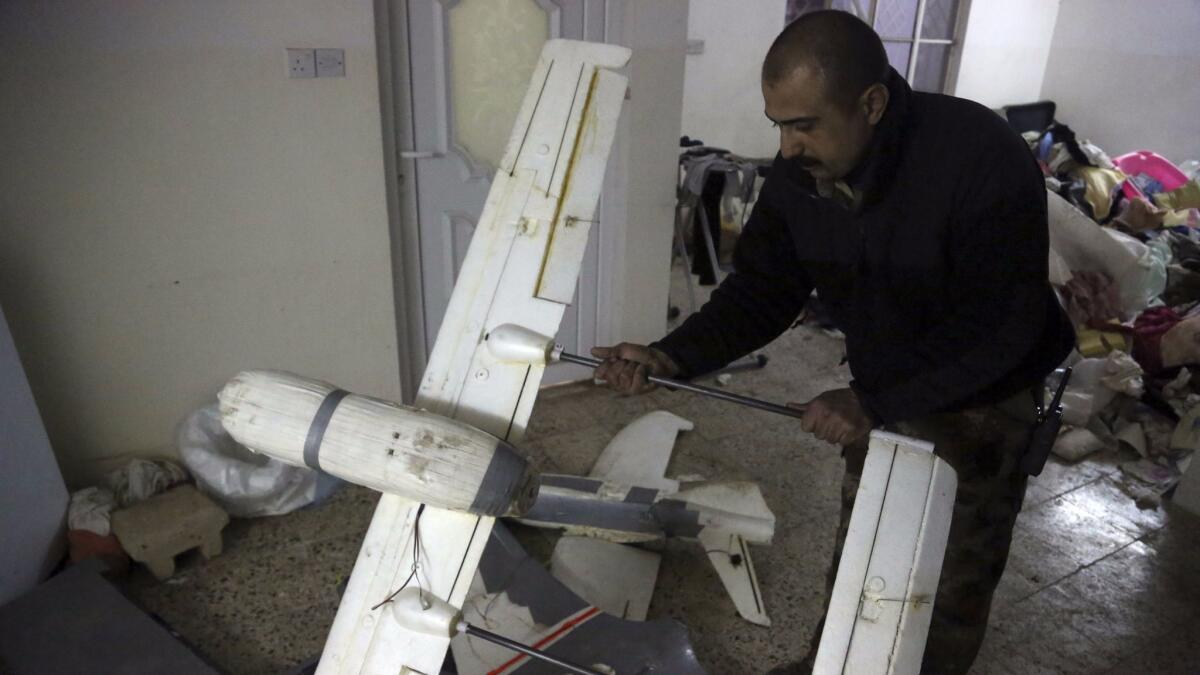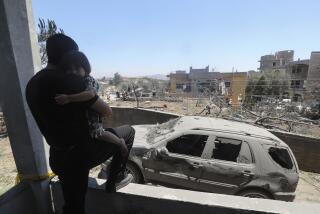Islamic State’s deadly drone operation is faltering, but U.S. commanders see broader danger ahead

Reporting from Washington — U.S. airstrikes and local militias in eastern Syria have hobbled Islamic State’s deadly drone program, U.S. officials say, but counter-terrorism experts warn that the terrorist group’s innovative use of the inexpensive technology may spur other aerial attacks around the globe.
A specially trained unit of Islamic State pilots flew small quadcopters and model-plane-sized drones, sometimes a dozen or more at a time, to stream live video of U.S.-backed ground forces and to drop crude munitions on them in both Iraq and Syria.
By evading ground defenses with remote-controlled devices purchased on the internet, the militants pioneered an asymmetric but successful tactic on the battlefield, much as the growing U.S. fleet of missile-firing Predator and Reaper drones has dramatically changed modern warfare.
During the battle for the Iraqi city of Mosul, which government forces recaptured in July, dozens of Iraqi troops were killed or wounded by 40-millimeter grenades and light explosives dropped from buzzing overhead devices so numerous that one U.S. commander likened them to killer bees.
It was, U.S. officials later acknowledged, perhaps the first time since the Vietnam War when the American military was largely powerless against enemy aircraft — in this case aircraft only a tiny fraction of the size of U.S. warplanes.
Until now, small drones mostly sparked security alerts in America by flying near the White House, near airports and in other restricted zones. But the growing availability and sophistication of commercial drones now are seen as a threat to the United States, some experts argue.
“We do know that terrorist organizations have an interest in using drones,” newly confirmed FBI Director Christopher Wray told a Senate hearing Wednesday. “We have seen that overseas already with some frequency. I think that the expectation is that it is coming here, imminently.”
Nicholas Rasmussen, the director of the National Counterterrorism Center, told the same panel that his agency has been coordinating with law enforcement and aviation regulators to study ways to defend against small drones used in terrorist attacks.
“Two years ago, this was not a problem,” he told the Senate Committee on Homeland Security and Governmental Affairs. “A year ago this was an emerging problem. Now it’s a real problem.”
Islamic State affiliates in the Philippines, Libya and Yemen already have used drones for surveillance. So have the Al Qaeda affiliate in Syria, Hezbollah in Lebanon, and the Taliban in Afghanistan.
Gen. Joseph F. Dunford Jr., chairman of the Joint Chiefs of Staff, told Congress on Tuesday that the Pentagon had made slow progress in countering Islamic State’s drones.
“It does create a significant challenge, and we have done all we can do today to deal with that challenge, as well as develop the capabilities we’ll need tomorrow,” he told the Senate Armed Services Committee.
Drones, he added, are “at the top of our list for current emerging threats.”
The threat spurred the Army to issue a handbook in April to urge commanders to assign dedicated observers to track small drones, and to train soldiers in what it called “Counter-Unmanned Aircraft System Techniques.”
Gen. Raymond Thomas, head of Special Operations Command, said small drones were the “most daunting” threat his commandos faced in Iraq and Syria last year.
He recalled once during the battle for Mosul when the Iraqi forces’ “effort nearly came to a screeching halt” because the sky was filled with buzzing robotic aircraft.
“At one point there were 12 killer bees, if you will, right overhead,” he said during a conference in Tampa, Fla., in May.
The Pentagon has rushed electronic jammers and other specialized equipment to help Iraqi security forces shoot down or neutralize Islamic State drones.
The Pentagon has also launched multimillion-dollar programs to improve defenses, including lasers that can disable a drone in the air and guns that fire small nets to nab them mid-flight.
Few of the gee-whiz measures have produced tactical success on the battlefield. Iraqis and U.S.-backed Syrian forces instead have tried to shoot them down with automatic weapons, with mixed success.
With few remedies, the U.S. has chiefly relied on targeted airstrikes. In some cases, crews used GPS data recovered from the targeting systems of downed drones that showed where they were launched, according to U.S. officials who were not authorized to speak publicly on intelligence matters.
Over the last two months, U.S. warplanes have destroyed several Islamic State drone depots, machine workshops and pilot schools, the officials said.
The airstrikes also killed eight commanders said to be responsible for obtaining, arming and distributing the drones down smuggling routes between Iraq and Syria.
Col. Ryan Dillon, the Baghdad-based spokesman for the campaign against Islamic State, said the U.S. sought to remove the militants’ “tactical ability to get their systems airborne.”
“We achieved the greatest effect against their program by simply killing the people that have weaponized it,” he said.
There are clear signs of success. U.S.-backed fighters have reported seeing seven small drones this month in Iraq and Syria, according to the U.S. military task force in Baghdad.
That’s down from more than 60 drone sightings earlier this year, especially during battle for Mosul.
Islamic State had a separate division to purchase the drones from commercial websites and other sources in China, India and Turkey, according to U.S. officials.
Engineers in Islamic State upgraded the power systems so the devices could fly longer and drop crude munitions on opposing forces.
Don Rassler, an analyst with the Combating Terrorism Center at West Point, said Islamic State used drones to overwhelm defenses as a deliberate tactic, part of a multiyear, detail-oriented military strategy.
Rassler and two colleagues studied, and subsequently published, internal Islamic State documents about the drone strategy that were recovered from Mosul.
The militants issued standardized “drone use reports” for pilots to fill out after each mission. The pilots were in a special unit, called the Baraa bin Malek Brigade, that was subordinate to Islamic State’s research and development arm, known as the Committee of Military Manufacturing and Development.
“The Islamic State established a bona fide bureaucracy to use drones on the battlefield,” Rassler said. “They have now shown other groups what is possible in using this technology.”
Peter W. Singer, a fellow at the nonprofit New America Foundation in Washington and author of “Wired for War,” a book on robotic warfare, said the Pentagon was caught flat-footed and is still scrambling for solutions. Terrorist groups will take note of that, he said.
“This is a threat that will only increase in the coming years,” he said. “The genie is out of the bottle.”
Twitter: @wjhenn
ALSO:
U.S. special operations forces face growing demands and increased risks
The U.S. is launching ‘danger-close’ drone strikes so risky they require Syrian militia approval
UPDATES:
1:40 p.m: This article was updated throughout with additional details and quotes.
This article was originally published at 3 a.m.
More to Read
Sign up for Essential California
The most important California stories and recommendations in your inbox every morning.
You may occasionally receive promotional content from the Los Angeles Times.










